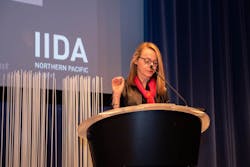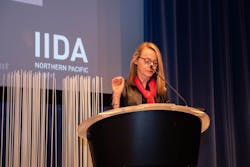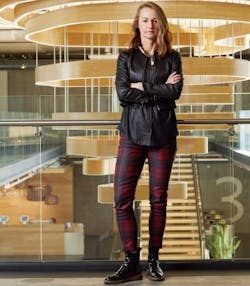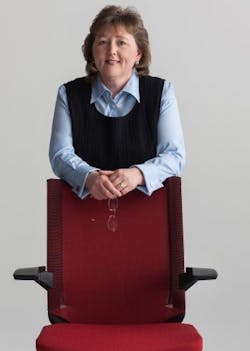More women than ever are in the design workforce, and 61% of designers are women, according to Design Census 2019 by AIGA and Google. The report found that women designers outnumber men in every kind of employment type, especially in school as students, which has been a common trend for years.
So, why, according to AIGA, do women in 2019 still hold only 11% of female leadership positions in the design field?
Perhaps it’s pay. After all, the Design Census revealed women earn less than 80 cents on the dollar compared to their male counterparts, and men are more likely than other genders to make more than $150,000 a year.
Or, maybe it’s a retention issue. The 2018 McKinsey & Company study “Women in the Workplace” found that particularly after five to 10 years of working, women face a lack of mentorship, celebration of female work, support for mothers and equal pay.
Rather than only reading the research, it’s important to include women in these discussions. What are women’s opinions, particularly those who currently hold leadership positions in the architecture and design community, on design leadership heading into a new decade?
A Leader’s Positive Perspective
Covarrubias is a female leader who wears many hats herself. She’s a studio director and creative director at Gensler in Seattle, and also serves as the firm’s regional design leader for the northwest region. Outside of Gensler, she co-directs a 30-member studio of young designers and serves on the board of the International Interior Design Association (IIDA), for which she was elected president in June 2019.
Photo: Susana Covarrubias, studio director and creative director at Gensler in Seattle.
Being a leader has always felt natural to her. She partly credits this to the strong women she grew up with in her family, both in Chile – where she was born – and the U.S., along with her educational background.
“I went to an all-girls private school, so I was exposed to a lot of women in leadership positions,” Covarrubias says.
She also notes that Gensler and IIDA have a history of promoting women within the workplace.
“Gensler has a history of elevating female leaders,” she says. “For example, one of our co-CEOs is a woman,” referring to Diane Hoskins, who manages Gensler’s 6,100-plus employees with colleague Andy Cohen.
IIDA is similarly led by a female-majority international board of directors, including executive vice president and CEO Cheryl Durst and vice president Gabrielle Bullock. Both women were featured in our February 2019 issue for their work to increase diversity in design and have positively influenced Covarrubias’ journey within the organization.
Role Models and Mentors in Design Leadership
Having been surrounded by influential women her entire life, Covarrubias believes that mentorship plays a huge role in how women view the workforce and their personal abilities within it.
She states that unlike in the past, “girls and women of today have a legacy of female designers they can look to as prime examples of successful women in the field.” Women such as Patricia Keller, Beverly Willis and Zaha Hadid are just a few who have become industry icons.
While there are many women who have paved and currently are paving the way, it’s still a statistical fact that most women designers don’t have enough women leaders, mentors and role models in their immediate surroundings. Covarrubias thinks this will need to be a key change in increasing the future number of female design leaders.
The 2018 McKinsey report found that men have more interactions with senior leaders, both inside and outside of work. The study states that employees who have regular interaction with upper management are more likely to remain at companies, be on the receiving end of promotions and, ultimately, land leadership roles.
Giving Women Access to Opportunities
When women have more access to opportunities, they are likely to take them, according to a study by leadership development consultancy Zenger/Folkman. The McKinsey report found that organizations benefit more from a mixed gender workplace for several reasons, including:
- More diverse problem-solving
- Increased organizational collaboration
- Boosted employee engagement
- Improved financial performance
However, factors outside of work can affect women’s climb to the top of the ladder. For example, the Design Census reports that designers across the board say there’s little childcare support, which takes a toll on new parents. It was rated as the least common workplace benefit – only 1% of those surveyed receive employer-provided childcare.
[Related: Mary-Jean Eastman Helps Pave the Way for Women in Architecture]
Covarrubias notes that, although things are slow to change, companies are starting to head in the right direction by embracing benefits such as flexible scheduling, paid parental leave, childcare services and even workplace design bonuses like privacy pods for nursing mothers.
Efforts to Increase the Number of Women Design Leaders
Looking at the statistics, a pipeline problem clearly isn’t the cause for the gap between women in the design field versus those in design leadership roles. Girls and women are interested in and are pursuing careers in design. Companies, however, must double-down on their efforts to retain, encourage and celebrate women in the field.
To help lead the workforce in the right direction, AIGA, the largest professional association for design in the U.S., launched “Double or Nothing” in 2018, a movement working to double the number of women leaders in design.
The movement launched with a website during Women’s History Month, and plans to continually expand by adding resources, toolkits, career advice and insights, and inspiring stories about female designers who are breaking boundaries in their field.
Double or Nothing aims to bring more than just awareness to the workforce; it’s working to create tangible impact and forge partnerships between women who want to lead, and organizations and individuals committed to helping them do so.
“Having women in the workforce has gone from being a ‘good’ thing to becoming an essential component of any workforce – it’s a competitive advantage,” notes Covarrubias.
There is no better time to level the playing field than now, as we get ready for a new year and decade. Companies looking to get involved on increasing the number of women leaders in design can join the Double or Nothing campaign, as well as contact [email protected].
Women looking to take their career a step further can also check out AIGA’s large collection of resources dedicated to women leading, including events, videos, articles and more. When it comes down to it, however, Covarrubias states that simply being authentic and confident in one’s self will go a long way, too.
“The world is ready,” she says. “Now is the time for women to take advantage of the platform that is forming. It’s a great time to go – and don’t hold back.”
Women in Design Leadership See Positive Direction for the Industry
Dozens of women currently hold a variety of leadership positions within the commercial interior design industry. When we asked several of them about their opinion on the current state of affairs for women, all shared Covarrubias’ positive outlook on where things were headed.
Susan Lyons | President, Designtex
Susan Lyons has been president of Designtex, a textile and wallcovering company, since 2012. Rather than focusing on only women, she says the design industry should take a look at diversity as a whole.
Of the 9,400-plus designers surveyed in the Design Census, 71% identified as white, while only 8% identified as Latinx or Hispanic and 3% as black or African American.
Photo: Susan Lyons, president of Designtex.
“It is important to have all groups represented so there is a diversity of experience and thought,” notes Lyons. Like Covarrubias, she agrees with the advantages that having a mentor holds.
“Seek out mentors,” she advices for women looking to pursue a leadership role. “Most people will be generous with their time and experience. Don’t be afraid to speak your mind.”
Ann-Marie Snook | President and CEO, Nienkämper
When Ann-Marie Snook was promoted this year to president and CEO of furniture manufacturer Nienkämper, she says she was pleasantly surprised by the encouragement she received at the time.
Snook says she was given an opportunity at a young age to prove herself and was recognized for her hard work and commitment to the company. “The culture at Nienkämper – then and now – led by Klaus Nienkämper, is rewarded with promotions based on performance, not based on gender.”
Photo: Ann-Marie Snook, president and CEO at Nienkämper.
By removing unconscious bias of what a leader “should” look like, Nienkämper is opening its doors to a wider talent pool.
“We focus on the individual and the skills they provide, regardless of their race or gender,” says Snook, noting the 34 different nationalities the company currently employs.
Erika Carey | Principal, Partners by Design
Erika Carey is one of seven principals, three of which are women, at her firm, Partners by Design.
She believes more women are entering leadership roles because of incredible trailblazers and a generational cultural change.
“It’s funny, although I rarely credit the internet – there is no denying its capacity to enlighten,” Carey notes. “If a young woman or girl is interested in design, architecture, construction or commercial real estate – they have the power at their fingertips to gain information to help them make informed decisions. If one googles women in ‘fill in the blank,’ there are countless articles, blogs and organizations to be found. When I started out, I had the Yellow Pages and the library as resource tools. To find any publication solely featuring a woman in leadership was scarce.”
Carey says that as more women take on and succeed in leadership roles, the momentum will increase too, provided their success stories are celebrated and shared.
Read next: International Women's Day Spotlight: Between Craft and Industry
About the Author

Adrian Schley
Associate Editor
Adrian Schley was an Associate Editor for i+s, where she covered the commercial interior design industry since 2018. Her work can also be found in BUILDINGS and Meetings Today.








